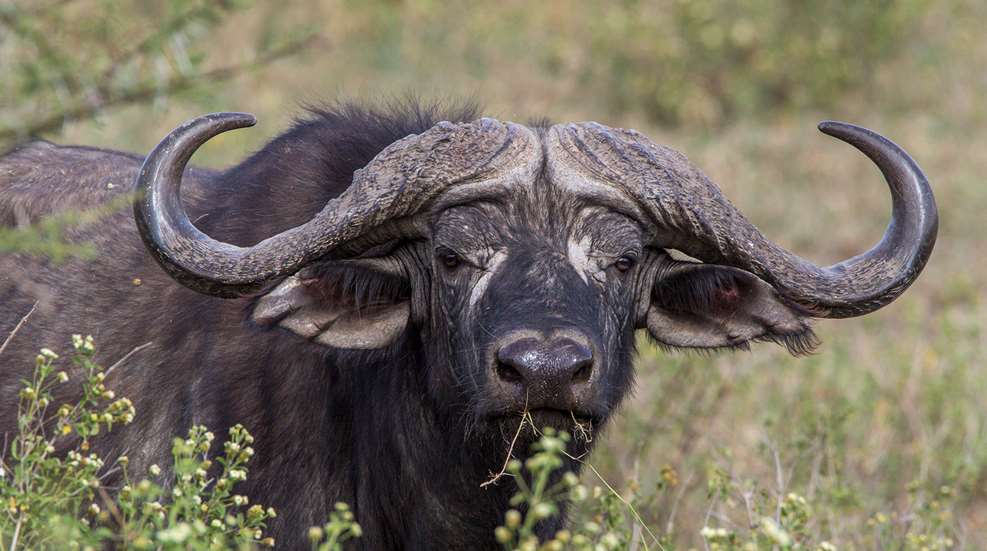
“Do you want to shoot a warthog?” Graham’s question was hurried and whisper quiet and, of course, bleeding of sophistication, as anything spoken with a South African accent is to an American audience. The combination made it all that much more alien to my ears, but he had that undeniable glint in his eye, recognizable the world over.
Being in South Africa, the question wasn’t entirely out of place, nor was the accent, but we were hot on the trail of a much bigger, much meaner critter, a Cape buffalo, literally following its footsteps in the sandy soil, so the question certainly seemed out of place. Following Stephen’s binocular, I spotted the low gray movement in the distance, and a skinny paintbrush tail pointing toward the burning sun. The answer was an immediate yes, and the reply was welcomed. Boom went the buffalo gun.
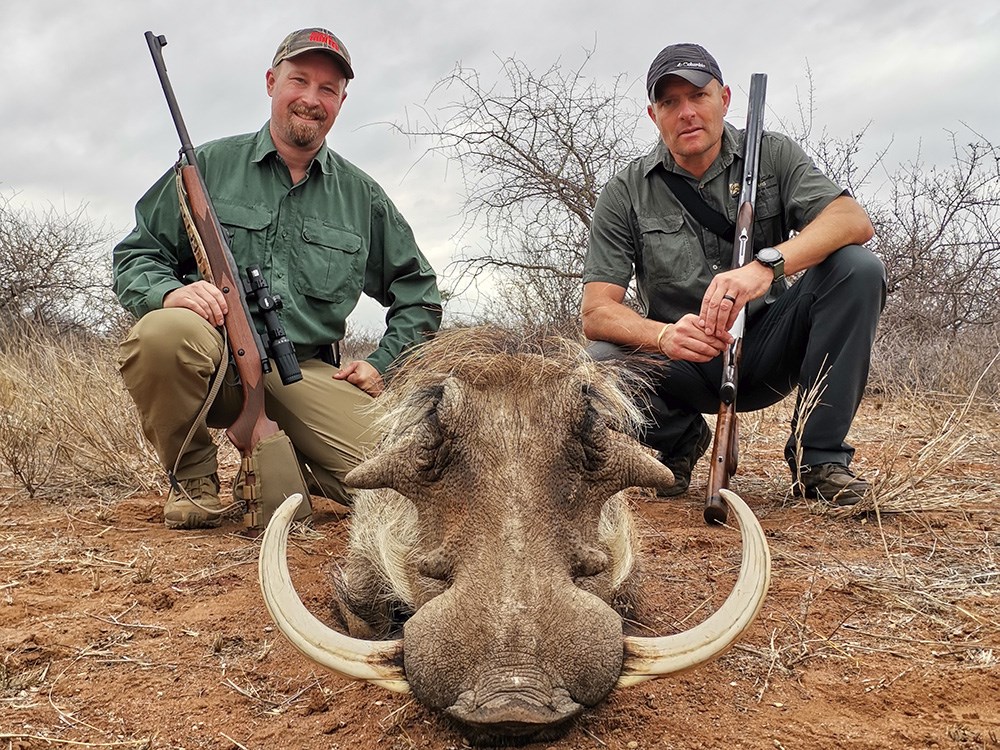
There was, in reality, more to it than that. In fact, I recall an instant, dare I say, moment of disappointment, upon first sighting the little tusker prancing its way through the bush. The initial excited reaction from my PH, Graham, and his head tracker, Stephen, made me think they’d spotted the buff, turning my already cranked adrenaline to 11 as I readied for an encounter with the black death. So, I was admittedly a bit shocked when I realized they had halted a buffalo hunt for a warthog—shocked, but willing. Despite not knowing a thing about field-judging warthogs, or any African animal for that matter, I knew enough at this point to trust Graham when he said shoot. Sticks went out, the rifle barked, and a 400-grain Nosler Partition dropped my adrenaline and about 4,500 ft.-lbs. of buffalo-killing energy into a 200-pound pig sporting tusks the size of which I’d likely never encounter again.
It was the afternoon of day two of my safari, and while I still hadn’t seen more than a glimpse of a buff, I was having a heckuva time with Graham felling game on the buffalo trail.
■ ■ ■
This was my second time placing boots on African soil. The first was Namibia in 2017 for plains game—a life-changing experience for any hunter. And now I was back on the continent where I’d sworn to return, this time in South Africa’s Great Limpopo Valley, and plains game was again on the menu, an amuse-bouche for another hunt said to change a man, the pièce de résistance: Cape buffalo.
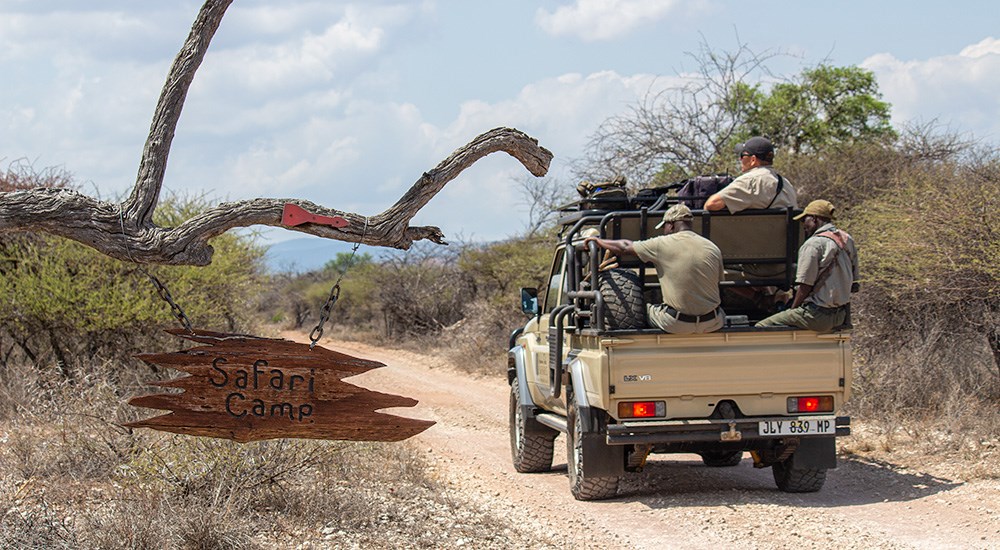
There as a guest of EOTech Inc. of Ann Arbor, Mich., and under the guiding care of professional hunter (PH) Graham Sales of Graham Sales Safaris, I was in the good company of friends old and new, tasked with grand adventure while putting the latest variable-power EOTech VUDU optics through the African ringer. Our hunting grounds, nearly 100,000 acres of privately owned game preserve teaming with wildlife of all kinds. High-fence, yes, but so is the rest of South Africa, and most of Texas for that matter, and this preserve encompasses a much larger plot of land than most of us hunt back home. I can’t say I didn’t see a fence, but I can say that if I didn’t want to, I wouldn’t have had to. The game certainly didn’t know they were fenced in, and besides, there are very few fences that could keep a rutting bull elephant or angry rhino somewhere he didn’t want to be, and they, along with the greater kudu, impala, giraffe, gemsbok, wildebeest, eland, buffalo and what seemed like a hundred other species—most of which could jump over or through any fence in sight (evidence of such abounded)—were all content being here, because that’s where the water was. Aside from the many well-fed concrete stock ponds dotting the landscape, there was a large lake on the far end of the property that fed a slew of streams that meandered through the preserve, allowing game to flourish and trackers to keep fresh fish on the table. This is big, wild, diverse country, nearly untamed, slightly augmented for the good of the animals that live here, and plenty dangerous.
■ ■ ■
“You said that you’ve already killed a blue wildebeest, correct?” asked Graham.
The rising sun was hiding behind clouds, keeping temperatures from their usual climb, requiring a light jacket for those of us riding high in the wind of the open rear rack bench. We’d left the dim light of the lodge less than an hour prior, plodding along at a fairly slow pace as we made our way to the far side of the preserve. It was day one, and I’d no idea what to expect in the coming week. All I knew was that atop the Land Cruiser, looking out across the vastness of huntable land, the waking African bush and cool morning air, I was flooded with euphoria. With wonder and opportunity all around, unique flora and seemingly limitless fauna—it was almost too much for a hunter to bear. Almost.
With a gentle tap on the metal doorframe, the vehicle slowed to a stop. A quick hand gesture signaled the driver, Kahunda, to put it into reverse.
“Because I think at least one of these is a good animal.”
I didn’t see a wildebeest.
When the rig stopped again, there they were. Seventy-five yards off the road, partially hidden in a swath of branches, three blue wildebeest stood staring in our direction, their dark silhouettes betraying them against the cool blue hues of a cloudy morning. Graham looked at me and smiled, “That’s a giant wildebeest.” The glimmer in his eye was nearly blinding. It was all the encouragement I needed.
Months prior, via email correspondence, Graham had asked if I had given any thought to the plains game I wanted to go after. I’d responded with a list of the animals I had taken in Namibia, and made clear that as a guest on this adventure, I was game for anything, but if we had the opportunity to add a new species to the list, well, I wouldn’t turn it down.
In camp the first day, after confirming zero on the rifles, Graham posed the question again, hoping to provide some direction, aside from buffalo, of course, to our upcoming outings. My response was simple, and one that I highly recommend; I told him that I wanted to go after any good representative animal we came across, particularly any animal that put a twinkle in his eye.
“Perfect,” he responded, “then we’ll hunt buffalo and see what we come across.”
The way I look at it, when you’ve got the potential to come across the equivalent of elk, mule deer, whitetail, pronghorn, black bear, moose, grizz and every other species of North American big game, plus 20 more, all on one property, what are you going to focus on? My answer: any and all of them. In my opinion, the idea of making a preferred list in Africa becomes a game of second guesses and missed opportunities. No, unless you’re Craig Boddington or some other choosy chap with preferred airline status and 15 trips under his wide-brimmed safari hat, I suggest letting the guide be your guide.
I had, as it turned out, killed a blue wildebeest in Namibia, but even without Graham’s encouragement I could tell the beast we had before us was much bigger. “Rifle, please.”
It was a short stalk initially, but the three bulls played the wind and kept circling our position. We played it better, and when I finally put my hands on him, I knew I had made the right call to trust Graham. Trust between hunter and PH plays an incredibly large role on safari, especially when dangerous game is on the menu, and ours was building.
■ ■ ■
“Whoa, what’s up with that eland?” I said to Graham. We’d been hunting all day, and with the evening approaching, decided the water hole a good place to watch game and take pictures for a bit before returning to the lodge. We'd come across the same herd of eland almost daily in our search for buff tracks, but something about this animal, aside from his obvious old age, was off.
“Looks like he’s got a tumor on his neck,” I added. Intrigued, Graham put the binocular to his eye to study the bull.
“That’s a very old eland,” he said, before breaking into Afrikaans—a local language that combines Dutch with the native tongues of South Africa—and a quick discussion with Stephen. With their conversation over, Graham turned to me and informed me that they had seen this bull three years prior, and the sight was obviously unforgettable.
The way Graham told it, he was the biggest bull they’d ever seen—the very definition of “in his prime.” He had a neck the size of a whisky barrel, swollen from musk and testosterone. A dominating presence, he owned the landscape and the cows on it, and garnered a wide berth from his competition, from which there was no match. A towering mass of muscle and bone. A sight to behold, truly.
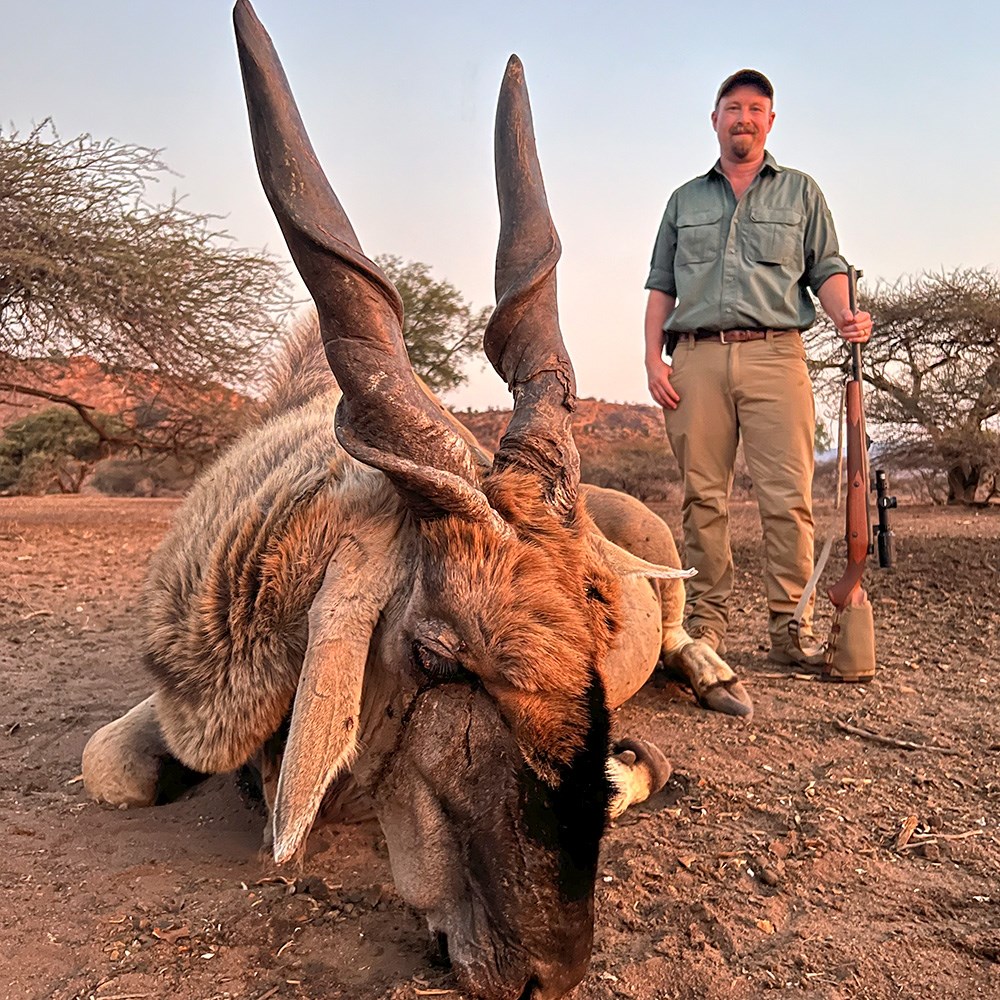 With its CRF and the heft to settle solidly on sticks, the .416 Rem. Mag. Winchester M70 Safari Express was the perfect medicine for nearly everything.
With its CRF and the heft to settle solidly on sticks, the .416 Rem. Mag. Winchester M70 Safari Express was the perfect medicine for nearly everything.
Now, he was a shadow of his former self, a wilted flower with the scars and cracked horns of a hard life, well spent. An old king usurped, tolerated to follow at the rear for as long as his legs would take him, leaving it to the leopards to decide when he’d go no further. His once swollen neck was now deflated, the empty skin hanging like a hobo’s tattered bindle over one side. His ribs were clearly visible, his spine was protruding, and his head hung low—always low. His gate was painfully slow, exhausting as little effort as possible in his daily struggle from shade to grass and to water. He couldn’t have kept up with the herd even if they allowed it, but as it was, they did not. He was battered and beaten, no doubt from his own kind, and he was not long for this world.
I don’t even think Graham was aware of how his eyes sparkled as he told me this tale, but it was brilliant. And I’ll be honest, it was the story that sold it. “He’s awesome,” I said. “Is there a reason we’re not going after him?”
Graham, who was far from attempting to make a sale, looked at me with the pure bliss a father would a son who’s just asked to go hunting for the first time.
It wasn’t hard to catch up, and I provided the old magnificent eland a mercy the bush would not have.
■ ■ ■
“Jon, I want you to put your gun over my shoulder.”
What? Did I just hear him correctly? Graham’s hushed instruction didn’t sound right, but he was serious, that much I could tell from his tone, as though I had just stepped on a land mine. So I just looked at him, perplexed, frozen, pondering what he might have said.
“Jon,” he said again, this time locking his eyes with mine, “I want you to step to your right, and put your rifle over my shoulder. Do it now.”
Yup, I heard him correctly, and this wasn’t a question, it was an order. But it was still a very odd request, so I simply whispered back, “Why?”
“Because the buffalo is feeding 40 yards to my left, and he has no idea we are here!”
As you may have heard, Cape buffalo are dangerous animals. That’s why you shoot them with big guns and big bullets. That’s why you have an experienced PH with a big gun and big bullets—Graham was sporting a .500 Nitro Express double. And that’s why you, as a hunter, do what you are told. Graham expected me to do just that, and I hesitated, because this was not at all how he told me it would go down.
The chase for this guy began earlier in the day, when my arm shot out, “Buffalo … there!” and the vehicle slowed to a stop. I was praying that my sighting wasn’t another false one. There’d been a few kudu at this point that seemed to turn into Mopane trees just as keener eyes began to scan the scene.
This one, however, did not. From our new angle, the buffalo, despite being the size of a Volkswagen, was barely visible, a black mass hidden in the shadows at the base of a tangle of bush just 50 yards off the dirt road.
“It’s a bull,” Graham informed from behind his binocular. “Let’s back up and give him a look.”
Game on. My heart was thumping out of my chest before the vehicle came to a halt some 500 yards back. On the ground, rifle in hand, Graham ordered me to chamber a round and reminded me of the instruction he’d been drilling into my head since we left the lodge the day before.
“Here’s how it will go down,” he’d said. “When we see a buffalo, I want you to stay right behind me. Stephen will set the sticks. When he does, you will mount your gun and find the buffalo in your sights. But do not shoot. I will be looking at the buffalo to judge that it’s the one we want, and will tell you exactly where to shoot him based on how he is standing. You do not shoot until I tell you where.”
It seemed simple enough, but Graham had done this enough to know it wasn’t a game, and had the personal experience to know what happens when things go wrong with a wounded buffalo. The buffalo would react accordingly, as his life depended on it. Ours did, too, and Graham made sure I was well aware of that fact.
“Again, you do not shoot until I tell you exactly where to shoot. Understood?”
I understood, and repeated the instruction word for word as we prepared for the stalk.
“Good. Stay close behind me.”
I followed a trail of two trackers and a PH as we crept slowly toward the location of the buff, circling wide to play the wind, as every successful predator does, man or beast. Confident in my duties, I simply stayed at the rear, turning my sweaty palms and white knuckles tightly around the wooden wrist of my rifle in an attempt to build some tack, while poking my head around Graham’s shoulder to stay abreast of the situation, doing all I could to stay close yet avoid rear-ending him when he slowed. Eventually the group halted and binoculars came up for a minute or so, then down, followed by a discussion in Afrikaans between the pros that while I couldn’t translate, I knew only meant one thing, the buff was gone. But he left an easy trail to follow—easy for a seasoned tracker, that is. So, into the bush after him we went. I repeated Graham’s instructions silently, along with a prayer.
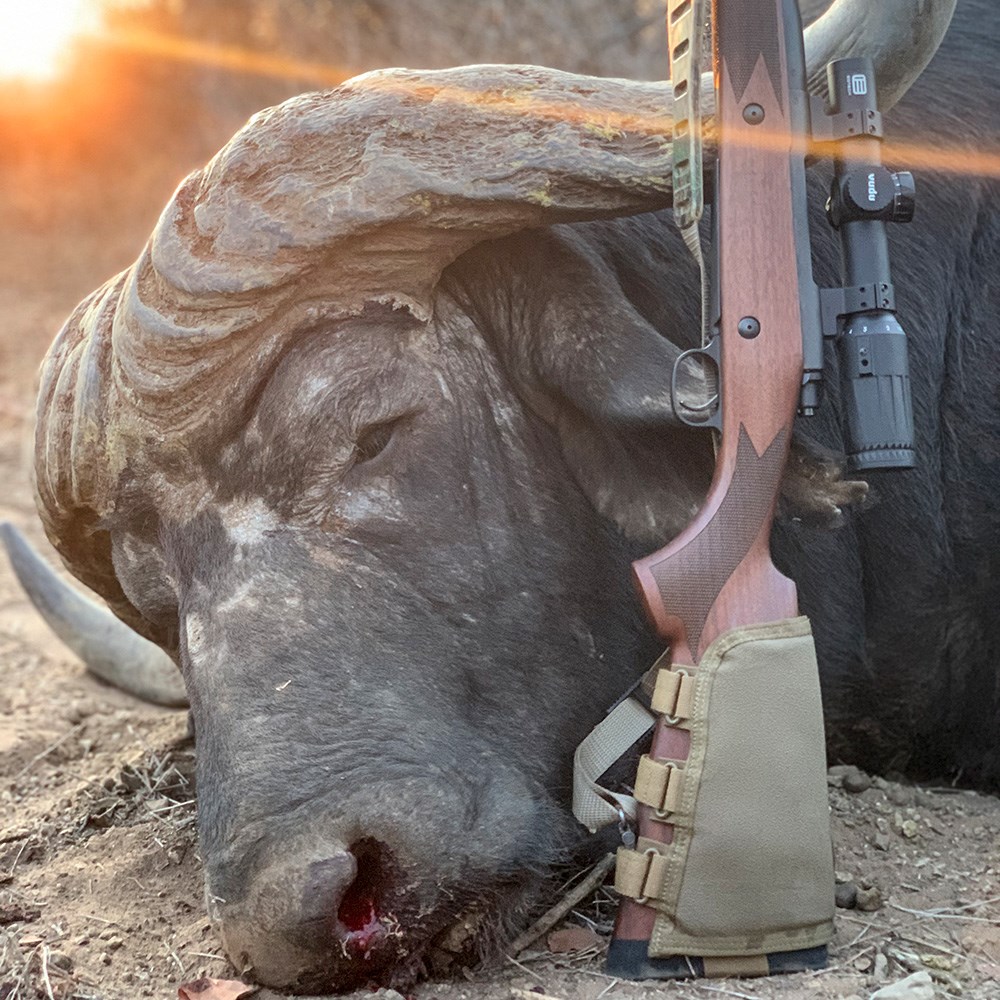
We’d walked about 2 miles when the bush went still, Graham's eyes twinkled, Stephen set the sticks, I nearly spontaneously combusted and that warthog—big enough to divert a buffalo hunt—entered stage left. Talk about an adrenaline dump.
With a dead pig to deal with and the sun high overhead, we headed back to the lodge for lunch and a nap, giving the buffalo plenty of time to find a shady spot and do the same. The trackers knew his direction, and shortly before 4 p.m., we headed out again, hoping to cut his tracks. It didn’t take long.
To say the bush was thick is an understatement. Visibility, at best, was a tight 20 yards, and oftentimes less than 10. We were a group of four, following the weaving trail of one of the most dangerous animals on the planet, wind permitting—a train of fleshy punching bags, lined up to be mowed over and gored, felled one-by-one like dominos if it switched. It was an uneasy feeling.
Our pace was slow and methodical. Every shadow could be a buff, every kudu cow that waited till the last moment to blow out could be a charge too close to defend against. Each time a tracker paused to glance ahead for what my brain determined was a millisecond too long, my heart would skip a beat. Something told me we wouldn’t be stopping again for anything but the buff, and if we found him in here, it was primed to be danger close.
Onward we marched, leaving boot prints atop buff prints as we worked our way through, hoping to close the distance, leaving it to chance the buff didn’t circle back to kill us. We had no idea how far behind him we were, yards or miles, but we’d follow the tracks until we caught up to him or ran out of light. My vote was for catching up—nighttime in this bush was something I could live without.
No worry, the wind was right and there was plenty of light left when no more than fifteen minutes later we walked up on the unsuspecting buffalo. The problem was, we weren’t expecting the buffalo either, not to appear where it did, anyway. As it happened, Stephen was about 7 yards ahead of us—with the shooting sticks—studying tracks that continued in that direction, when Graham, content with the empty trail ahead, lowered his binocular and decided to glance to the left. The buff was just standing there.
An unaware and feeding buff was a gift Graham wasn’t soon to give up, so rather than risk blowing our cover, he halted Stephen's attempt at delivering the sticks and calmly instructed me to put the rifle over his shoulder. Unorthodox, yes, but with no other option I stepped to the right, placed that heavy barrel over Graham’s right shoulder, found the buff in my sights and awaited my instruction on where to shoot. And waited … and waited.
I don’t know if it was a fraction of a second or a full five, but when you’ve got a Cape buffalo unaware and broadside at 40 yards, crosshairs hovering over the front shoulder, any amount of waiting feels too long. The instruction didn’t come, but I didn’t want to be the one to break protocol any more than it already had been, so I spat out, “Where do you want me to hit him?” I got no response.
Frantic, I repeated the question. “Graham, where do I shoot him?” Still, no response. I gave it another half-second before I took my eyes off the scope and turned my gaze ever so slightly in his direction while repeating the question again, louder this time. And wouldn’t you know it, with a .416 about to go off mere inches from his face, Graham had done the only logical thing and buried his fingers deep in his ears and turned his head hard to the left. I imagine his eyes were closed boogeyman-tight, too—I know mine would have been. Unbeknownst to me, we had scrapped the plan.
Wondering why in the hell I hadn’t shot yet, Graham turned to meet my gaze, and commanded, “Shoot the buffalo, now!” and quickly spun his head away once again. He may have added a four-letter descriptor for effect, and it did the job. Eyes through the scope again, the once broadside buffalo had heard the commotion, turned and was now facing us, head up, nostrils flaring, and very much aware of our presence. He had us dead-to-rights. This is not how it was supposed to happen.
Boom went the buffalo gun.
I wish I could report that the buffalo was felled right then and there, but things were a little more exciting than that. As it turned out, there were two buffalo on the scene, the second showing itself to Graham after the shot went off. The pair took off side-by-side, and without being able to determine which was which, Graham nixed the follow-up shot and they disappeared in a cloud of dust and calamity. We took off in hot pursuit.
After a mile or so of tracking, the wind at our backs, of course, the worst-case scenario was becoming reality. The two buffalo were staying together, one wounded, one not. Not a good situation. The tracks told the tale, and the trackers could read it clearly. The wounded buffalo, knowing there is safety in numbers, wanted nothing more than to stay with the healthy buffalo. He could obviously still keep up, even though the early blood trail spoke of a decent hit. The healthy buffalo wanted to get the heck out of Dodge, putting as many running steps between him and danger as his body would allow, but his running mate was wounded—he could smell the blood, and blood brings danger.
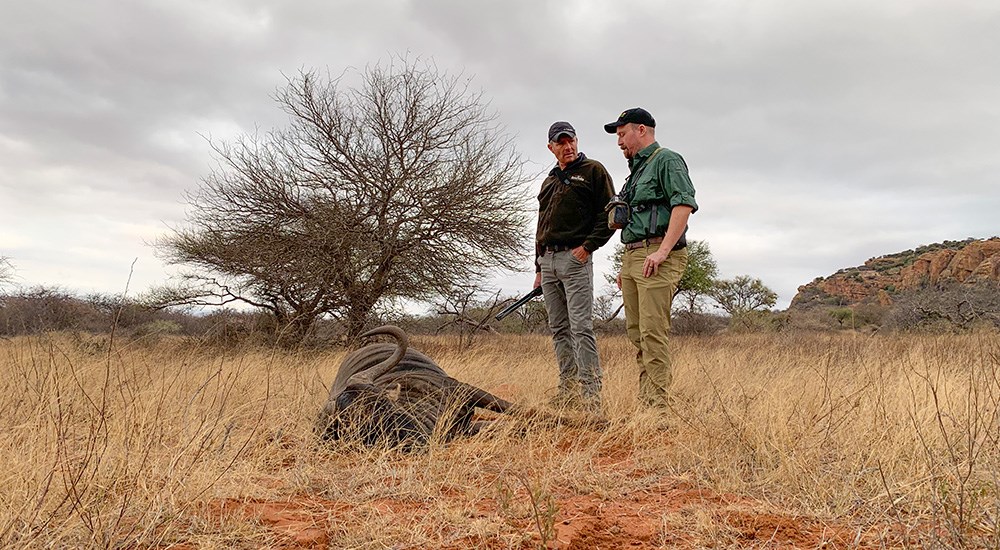 With so much game around, one has the ability on safari to both show off and get shown up. Plenty of practice shooting off sticks is paramount to success.
With so much game around, one has the ability on safari to both show off and get shown up. Plenty of practice shooting off sticks is paramount to success.
We continued on, the incredible tale unfolding with every step. There was more blood, deep turning tracks, evidence of buff on the ground, battle scars in the dirt. Instinct, I suppose, made it an easy choice: kill or be killed. So with the wounded buffalo refusing to stop its progression, the healthy buffalo turned to stop him. I imagine it was a brutal beating, but the buff’s will to live was strong, and he continued to follow despite the danger now on both ends—the devil you know, I guess.
With the sun nearing the horizon, the call was made for me. I knew there was no recourse but to maintain my trust in Graham. We would find this bull again the following day, he assured me, dead or alive. You can imagine one doesn’t sleep after an event like that, and you’d be right. But I was rigged and ready well before the coffee was come morning, and once we hit the road—this time with a few more trackers and an extra PH as backup—it didn’t take long to cut the tracks. Only this time, there were four sets, turning this into an even more dangerous scenario for us and, as the awesome picture the tracks painted showed, an even more dangerous situation for the wounded buff. If I thought the beating from one healthy buffalo was bad, the three of them pounding, hooking, gouging and kicking must have been hell. It did the job though, and the tracks of the wounded buff split off from the group after that.
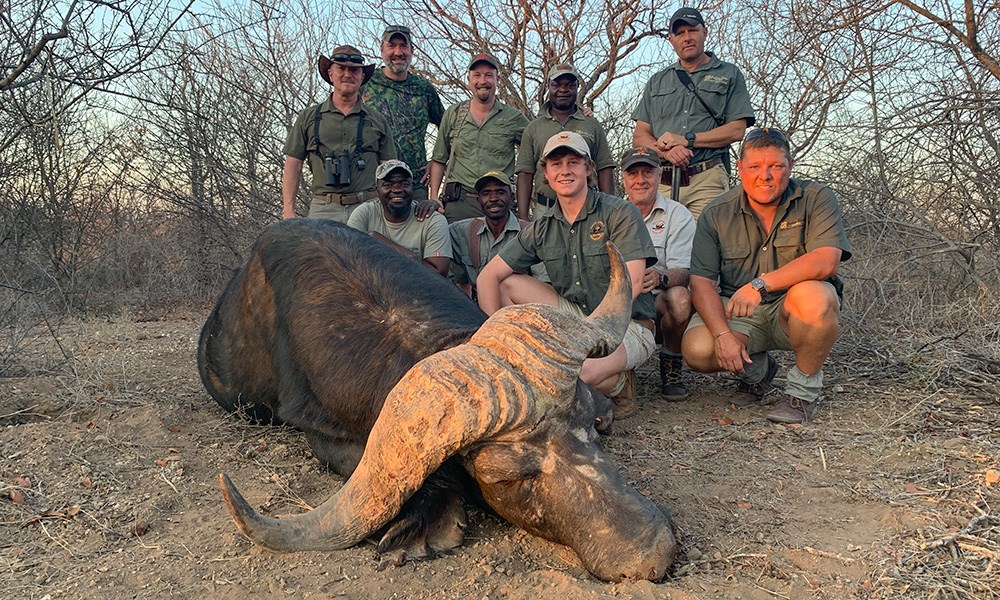 Graham and his team are second to none. If you're looking to book a safari for plains game, buffalo, leopard or anything else, visit grahamsalessafaris.com.
Graham and his team are second to none. If you're looking to book a safari for plains game, buffalo, leopard or anything else, visit grahamsalessafaris.com.
We caught up to him with about 80 yards between us. He was on his feet, at the treeline on the far side of a clearing, and he knew we were there. Again, he turned to face us. Stephen set the sticks, the gun went up, and the buffalo burst forward, turning broadside for a moment as he dodged a small bush that separated him from the threat he was now determined to eliminate.
I didn’t wait for instruction. Boom went the buffalo gun.
EOTech on Safari
While you could probably find a place for their battle-proven Holographic Weapons Sight on safari—I’m thinking crocodile—EOTech's extensive and expanding VUDU line of variable-power optics is top notch and provides the best options for hunters.
For plains game, I wanted something that could reach out, so I looked to the VUDU 3.5-18x50 SFP. It sports a 34mm, one-piece, aircraft-grade aluminum main tube, HD glass with anti-reflective coatings and a sunshade to drown out the African sun, and it's EOTech-durable. Its second-focal-plane HC1 reticle sports short MOA hashmarks along both axes, providing the means for accurate long-range shooting. Attached to my Gunwerks Magnus rifle in .300 Win. Mag., and calibrated with Hornady’s 200-grain Precision Hunter ELD-X ammo, I was able to set my rig for a tack-driving maximum-point-blank-range of 325 yards, with proven DOPE to go much farther. And when Graham finally got tired of me hitting game a tad high and convinced me that all my shots would likely be 100 yards or less, with eight confident clicks of the top turret I was there and dead-on again to drop an impressive impala. Delivering that kind of confidence and dependability to the user, on the range and especially in the field where it counts most, is what sets EOTech apart.
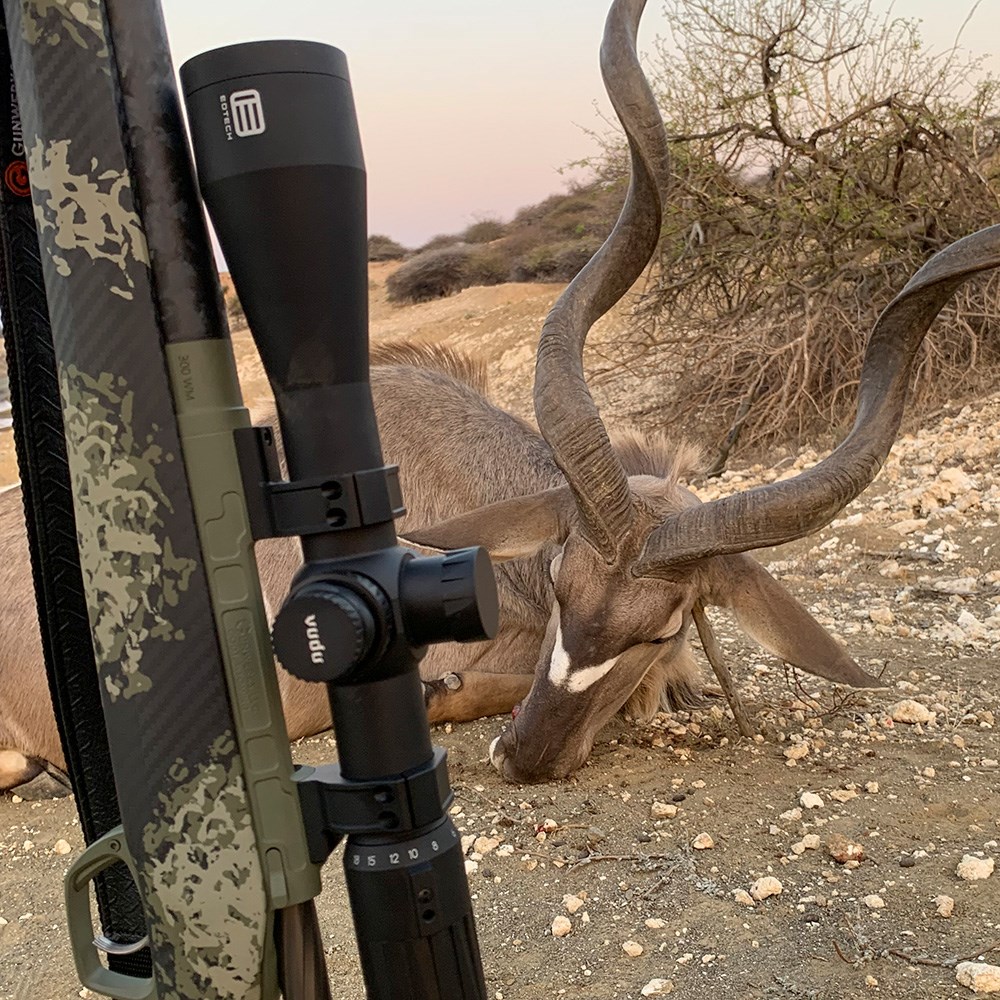
The Cape buffalo is a vastly different animal that requires vastly different tools. I knew when it came to topping my buffalo gun, a Winchester Model 70 Safari Express in .416 Rem. Mag., I wanted a low-power variable optic for fast target acquisition, a wide field-of-view and the variability required to take quick shots at 35 yards, as well as place bullets in the X at 200 hundred yards or more. Built with the battlefield-worthy standards for quality and function EOTech is known for—meaning it will work when you need it to—the EOTech Vudu 1-6x24 FFP with the SR1 reticle sports a magnification range fitting the proverbial “Goldilocks zone.” A true 1X with generous eye relief, it utilizes an ultra-fast speed-ring illuminated reticle at low power, and a hashmarked cross at 6X that offered uncomplicated subtension hashmarks to compensate for range and windage. With an overall length less than 11 inches and a 30mm tube, it was sized perfectly for my rifle and purpose. I liked the combo so much that I shot the majority of my animals with it on this trip, including a jackal!
All that aside, I should have gone for a second-focal-plane optic atop my dangerous game rig. First, I didn’t need all the subtension hashmarks the FFP SR1 reticle provides at high magnification; dangerous-game distances kept me under 4X the entire trip, and there’s simply no time or use for compensation at those ranges, especially with a .416. Second, and perhaps more important, at lower power, 1X-3X, the center crosshairs of the SR1 reticle were a tad hard to see in low light. Illumination eliminated that issue; red or green are both available, but it’s an extra step to activate, and simple is always better when it comes to dangerous game. A better choice would have been EOTech’s VUDU 1-8x24 SFP optic with a simple HC3 duplex-type reticle with an illuminated red center dot. It’s got everything you need for dangerous game and nothing you don’t.


































